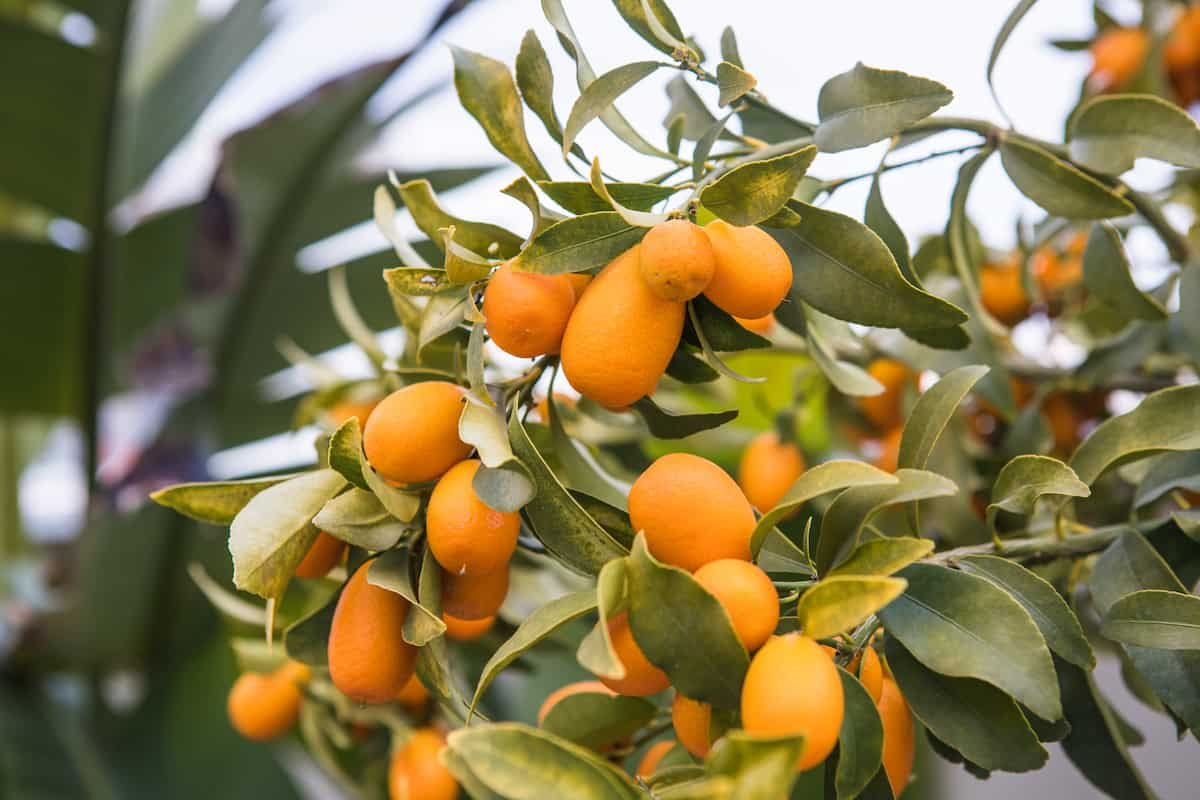Kumquats are small citrus fruits that resemble oranges in colour but are much smaller in size. They are popular for their tangy, sweet taste and are often used in marmalades, jellies, and other preserves. Growing kumquats can be a rewarding experience for gardeners of all skill levels. In this guide, we’ll walk you through everything you need to know to grow, care for, and harvest your kumquat tree. Below we learn how to grow kumquat from seeds, growing kumquat in pots/yard, and kumquat tree care.

Guide to Growing Kumquat
Choosing the Right Variety
There are several kumquat varieties to choose from, with the most popular being Nagami, Marumi, and Calamondin. Nagami kumquats are oval-shaped, with a tart flavour and thin skin. Marumi kumquats are spherical and delicious, whereas Calamondins are hybrids with a peculiar sweet-sour flavour. Select a variety that appeals to your taste and is suitable for your climate.
Selecting the Perfect Location
Kumquat trees thrive in subtropical and tropical climates, preferring full sun and well-draining soil. Find an area in your garden where there will be sunshine for at least six hours a day. Root rot may be avoided by making sure the soil drains well. Planting your kumquat tree on a raised bed or container can help it drain better if you live in an area with thick clay soil.
Planting your Kumquat Tree
When to Plant
The best time to plant a kumquat tree is in the early spring, once the threat of frost has passed. This allows the tree to establish itself before the heat of summer arrives.
Preparing the Soil
Before planting, add compost or aged manure to promote soil fertility and drainage. This will provide your kumquat tree with the necessary nutrients for healthy growth. Test the soil’s pH, ideally between 6.0 and 7.0. If needed, amend the soil with lime or sulfur to adjust the pH.
Planting Procedure
Prepare a hole double the size and depth of your kumquat tree’s root ball. Remove the tree from the container carefully so as not to disturb the roots. Before planting the tree, ensure the root ball is flush with the soil. To avoid air bubbles, fill the hole with dirt and carefully pack it down. In order to help the soil settle, water the tree thoroughly.
Watering and Fertilizing
Watering
Kumquat trees require consistent moisture, especially during their first few years. Give your tree consistent, in-depth waterings, but let the soil dry up somewhat in between waterings. Overwatering may cause root rot, so be cautious.
Fertilizing
Feed your kumquat tree with a balanced, slow-release citrus fertiliser, following the package instructions for application rates and frequency. Typically, you’ll need to fertilise three times a year: in spring, summer, and fall.
Pruning and Shaping
Maintaining the health and form of your kumquat tree requires regular trimming. Before the new growth emerges in the spring, prune in the late winter. Take down any branches that are diseased, broken, or overlapping. Also, trim branches growing towards the tree’s centre to maintain good air circulation. You can shape your tree into a particular form, such as a bush or standard. To promote bush y growth, prune the central leader and encourage lateral branching. Remove lower branches and maintain a single, upright trunk for a standard form.
In case you missed it: How to Grow Rose Apple / Wax Apple / Water Apple / Java Apple from Seed: Planting and Care

Pest and Disease Management
Kumquat trees are relatively pest-resistant but can still be affected by common citrus pests like aphids, scale insects, and spider mites. Check for any symptoms of infestation, and use insecticidal soap or horticultural oil as required. Some diseases affecting kumquat trees include citrus canker, root rot, and greasy spot. To prevent these diseases, maintain good air circulation around the tree, avoid overwatering, and apply a copper-based fungicide if necessary.
Supporting the Tree
As your kumquat tree grows, it may need support to prevent branches from breaking under the weight of the fruit. Place wooden or metal stakes in the ground next to the branches and secure them with soft ties, allowing room for growth.
Mulching and Weed Control
Apply a 2-3 inch layer of organic mulch, such as shredded bark or straw, around your kumquat tree to retain soil moisture and inhibit weed development. To avoid decay and bugs, mulch the trunk a few inches away. Regularly check the area for weeds and remove them as needed, ensuring not to disturb the tree’s shallow root system.
Preparing for Winter
In colder climates, kumquat trees may need protection during winter months. Move your containerized tree to a safe spot or inside near a sunny window. For in-ground trees, protect the trunk and roots with a layer of mulch and wrap the branches with burlap or frost cloth to insulate them from cold temperatures.
Harvesting your Kumquats
Depending on the variety and climate, kumquats typically ripen between November and March. The fruit is ready to harvest when it turns a bright orange color and has a slightly soft texture. To pick kumquats, gently twist the fruit from the tree, not damaging the stem. Kumquats can be eaten fresh, preserved, or used in various recipes.
Propagating Kumquat Trees
There are several ways to propagate kumquat trees, including from seeds, cuttings, and grafting. To grow a tree from seed, collect seeds from ripe kumquats, clean them, and allow them to dry. Plant the seeds in potting mix that has good drainage, and be sure to keep them damp and warm until the seeds germinate. Be aware that seedlings may not produce fruit identical to the parent tree.
In case you missed it: Ultimate Guide to Growing Taiwan Pink Guava: How to Plant, Prune, Care, and Harvest

For a more reliable method, consider propagating from cuttings or grafting onto a compatible rootstock. Take semi-hardwood cuttings in late summer and root them in a well-draining medium. Grafting involves joining a kumquat scion onto a rootstock, such as a trifoliate orange or citrange, which offers better disease resistance and improved fruit production.
Conclusion
Growing kumquat trees can be fulfilling, providing you with beautiful, fragrant blossoms and delicious, tangy fruit. Following this guide will help you develop, care for, and harvest a kumquat tree.
- Feed Your Flock for Less: Top 10 Tips to Save on Chicken Feed
- Ultimate Guide to Ossabaw Island Hog: Breeding, Raising, Diet, and Care
- Hatching Answers: The Top 10 Reasons Your Chickens Aren’t Laying Eggs
- Eggs and Economics: Breaking Down the Cost of Raising Backyard Chickens
- Defend Your Greens: Proven Methods to Keep Iguanas Out of Your Garden
- Ultimate Guide to Cinnamon Queen Chicken: A Comprehensive Guide for Beginners
- Ultimate Guide to California Tan Chicken: Breeding, Raising, Diet, Egg-Production and Care
- Ultimate Guide to Marsh Daisy Chicken: Breeding, Raising, Diet, and Care
- 10 Types of Chicken Farming Businesses You Can Start for Profits